Download Pdf [4,89 MB] - MTU Aero Engines
Download Pdf [4,89 MB] - MTU Aero Engines
Download Pdf [4,89 MB] - MTU Aero Engines
You also want an ePaper? Increase the reach of your titles
YUMPU automatically turns print PDFs into web optimized ePapers that Google loves.
Reports<br />
26 REPORT<br />
Lifesaving<br />
logistics<br />
By Clemens Bollinger<br />
A child’s heart on its way to the transplantation room, hospital flights from vacation regions, evacuation after<br />
natural disasters: three key facets of ‘lifesaving logistics’, of an increasingly close symbiosis between aviation and<br />
medicine. It is foremost the aircraft that offers efficient lifesaving transportation with medical care en route.<br />
Flying the way it used to be, that’s what the<br />
German Air Force (GAF) pilots flying humanitarian<br />
missions ought to have down pat. “In<br />
their indoctrination and continued training,<br />
we’re still putting a high priority on flying and<br />
landing by compass needle and stop watch,”<br />
says GAF major André Geisler. “After all, we<br />
never know for sure what’s waiting for us at<br />
the destination. Perhaps they have some<br />
decrepit old navaid system running there, or<br />
maybe not, and maybe it just up and died<br />
meanwhile.”<br />
Commander of an Airbus A310, Major<br />
Geisler is part of the parent cadre of the<br />
Special Air Mission Wing, Federal Ministry of<br />
Defense, at the Cologne/Bonn airport. It’s<br />
from this airport that he has flown to all continents,<br />
embarked on many trips, travelling<br />
with ‘very important politicians’ and hauling<br />
myriad tons of relief supplies to crisis<br />
regions in Asia and Africa, and made those<br />
special flights as the commander of a flying<br />
intensive-care unit, the GAF’s Airbus<br />
MedEvac transport.<br />
Its MedEvac operations are luring interested<br />
parties from across the globe to the GAF<br />
hangars at Köln-Wahn. The acronym stands<br />
for Medical Evacuation, and in this case for<br />
the presently unique capability to pick up as<br />
many as 56 injured people and fly them<br />
home, from wherever they may be, providing<br />
medical care underway. That’s the way it was<br />
in Congo, Sudan, Mexico and most recently<br />
Thailand, where in 2004 a tsunami crippled<br />
the country with an apocalyptic visitation at<br />
the turn of the year.<br />
It was a medical Airbus transport flying<br />
under the German national ensign that first<br />
reached Phuket to evacuate German citizens<br />
and other seriously injured Europeans, and<br />
that steadfastly remained when all other rescue<br />
teams had already flown off in awed<br />
anticipation of a second sea wave. At that<br />
time, the flying hospital had not finished<br />
loading yet, and speed and nerve were of the<br />
essence. When the jet finally taxied to the<br />
take-off runway, doctors and medics hung on<br />
for dear life among the aluminum frames of<br />
stretchers holding injured people.<br />
If not earlier, it was since these dramatic<br />
days marked by continuous missions of 80<br />
hours and more that the Special Air Mission<br />
Wing with its very special medical logistics<br />
has been thrust into the spotlight. High-profile<br />
voices call it a landmark of German foreign<br />
and security politics.<br />
The German MedEvac aircraft are Airbus<br />
A310s operated by the Special Air Mission<br />
Wing. Of the totally seven airplanes, bought<br />
secondhand in the nineties, four were retrofitted<br />
for multi-role transport (MRT) and one<br />
as a permanently available emergency hospital.<br />
The MedEvac airplane can be aloft just hours<br />
after the alert. Lieutenant colonel, Medical<br />
Corps, Dr. Karlheinz Fuchs, as the medical<br />
chief, has been onboard on practically all of<br />
the missions. “The book says we have 24<br />
hours to ready for takeoff, but we can do it in<br />
eight or so. What we do is fly medical specialists<br />
and medics from all over Germany to<br />
our base, assemble them into a team, brief<br />
them, and off we go.”<br />
REPORT 27


![Download Pdf [4,89 MB] - MTU Aero Engines](https://img.yumpu.com/5322947/14/500x640/download-pdf-489-mb-mtu-aero-engines.jpg)


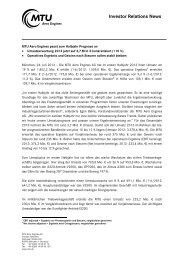
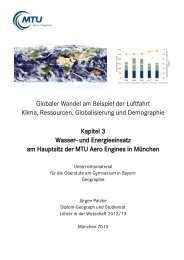
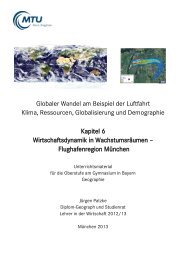
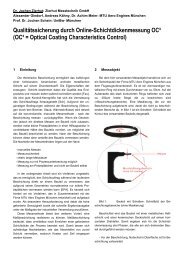
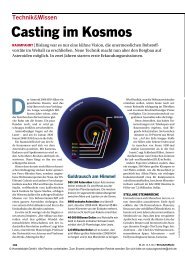

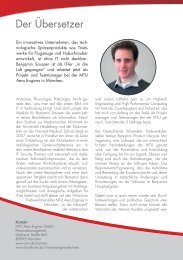
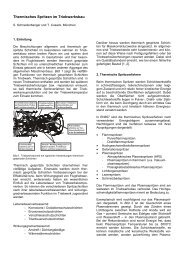
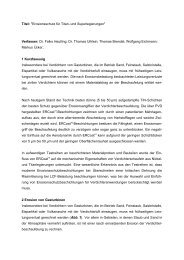


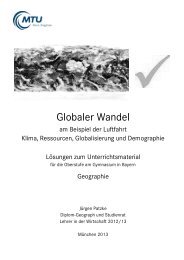
![Download PDF [5,37 MB] - MTU Aero Engines](https://img.yumpu.com/21945461/1/190x125/download-pdf-537-mb-mtu-aero-engines.jpg?quality=85)